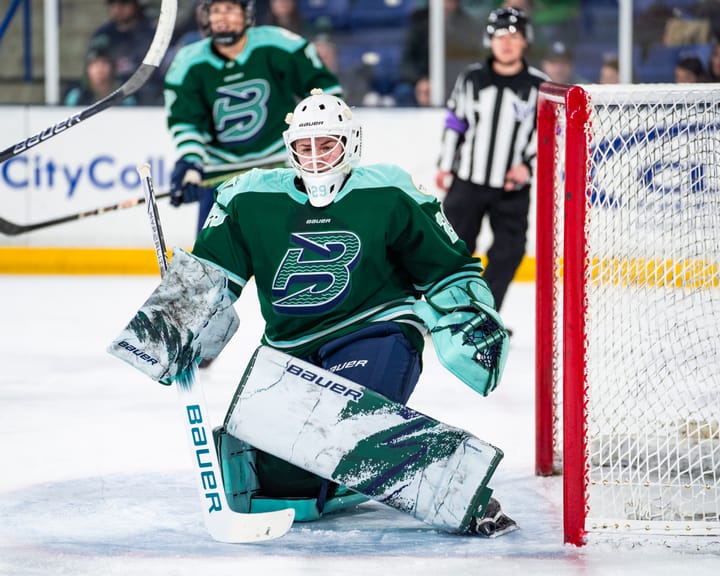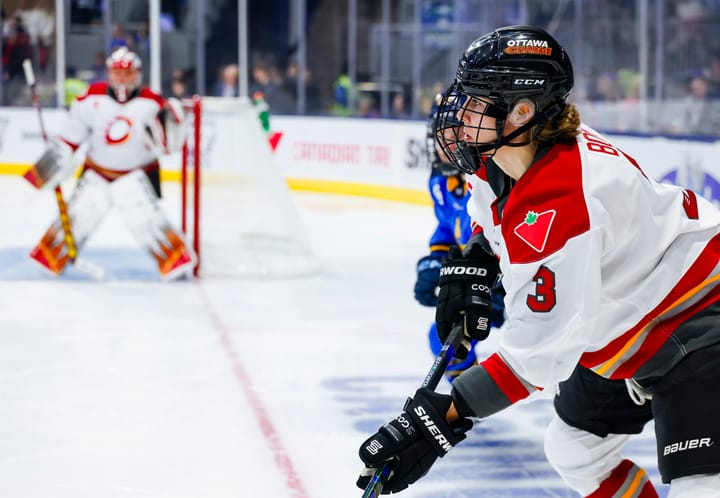A Conversation With Peter Elander
From Sweden’s Mirakel on Ice to Peter’s Ice Palace in North Dakota, Peter Elander has made his mark on women’s hockey all over the world.
Interstate 70, the eastbound artery into Columbus, is a tolerable if uninspiring stretch of highway through the Midwestern heartland. Depending on the perspective, this is Middle America or the middle of nowhere. It’s not a place anyone would expect to find a legendary Nordic women’s hockey coach, yet the city of Columbus and specifically, The Ohio State University, are home to Peter Elander’s next great adventure.
We meet in a hallway of St. John Arena, a breezeway’s walk from the OSU Ice Rink. Elander emerges from the player’s lounge wearing a knit sweater, comfortable scarlet and grey wool in the Buckeyes’ colors. Since it’s a brisk and sunny afternoon he suggests we take advantage of the weather, so we head outside. There are no benches to be found; we hop up on a concrete planter near Remembrance Park and make do.
The Tyringe, Sweden native has had a front-row seat to some of the most dramatic highs and lows across the sporting landscape over his nearly 20 years in women’s hockey. He coached the Damkronorna to the 2006 Turin “Mirakel” where Sweden upset a heavily-favored American team to advance to the gold medal game and bring home the team’s first-ever Olympic silver medal. He was also a longtime associate coach at the University of North Dakota, present this past spring when the women’s hockey program was cut with all the tact and sensitivity of a battlefield amputation.
Related
University of North Dakota cuts women's ice hockey program
Elander, like the players themselves, was on the ice for a skill session when the word came down. He says the news wasn’t a complete shock:
“I had my hints there. They were like, not hints, but my suspicions. I was supposed to have a meeting with the athletic director about my new contract on Friday. He was not available on Friday, even if we had set up a meeting…
“They hired a soccer coach on Monday, so we knew, they’re not gonna cut the soccer program.”
The decision left him at a crossroads. As a veteran coach with a winning record, Elander didn’t lack options or offers. He considered returning to Sweden, possibly to a position in the SDHL, but his family factored in his decision just as much as his own desire.
“My son is going into eighth grade and my wife is Canadian, so. And this was coming up here, but yeah. It took some time to make up the decision, because it’s a whole...it’s like moving a family, too.”
Second-year coach Nadine Muzerall made it a priority to get Elander to OSU. While other universities looked to recruit the now-transient North Dakota players, her gaze fixed firmly on recruiting Elander.
“A lot of people are going after the players from North Dakota and I thought that was a short-term advantage whereas Peter will be long-term with his hockey IQ and with his wealth and knowledge of the game as well as his connections to the European players,” she told The Lantern in September.
In addition to seeing one of the keenest and most formidable hockey minds in the game today, Muzerall recognized two of Elander’s other great assets: his connections and his recruiting skills. During his time at North Dakota he brought in 10 student-athletes from six different countries, including Sweden’s Johanna Fällman, Germany’s Tanja Eisenshmid, and Finland’s Michelle Karvinen.
Elander credits his track record to hard work and commitment. He maintains a home base in Sweden during the summertime and travels extensively during the season, both in the United States and abroad.
“I spend more time (recruiting) than any other school in Europe,” he says more than once during our conversation. “Recruiting is a lot of having a good scouting eye and then at the same time log the hours.
He also looks at more than hockey, focusing on the academic commitment required for student-athlete success. “Do they really want to go and study at the same time as they play hockey?
“It is kind of like two full-time jobs, both playing and studying at the same time,” I add, nodding.
“Someone said, ‘it learns you time management.’ Like, as an adult, time management,” he continues. “Are you going to have a good family life? Then time management is a factor. If you’re going to have time for your kids, that’s the time management. It’s the same thing.”
I ask about the YouTube channel bearing his name.
“A channel, with my name?”
After a brief explanation, his face lights up. “Yeah! Yeah, yeah. One of my fondest memories in North Dakota...you could finally do your own backyard rink.”
It’s impossible not to smile at that. Happy memories have a way of bringing a glow out of people, and Elander is no different as he describes the scene for me:
“I did a backyard rink and it was the size of this...this was like, 70 feet times 30, and it was apple tree lights, and it was guarded in so there was no wind. I walked down from the kitchen, and it was called Peter’s Ice Palace.”
“Every Martin Luther King Day we played [an] outdoor Winter Classic For World Peace with some celebrities. Eisenschmid, and [the] Lamoureuxs. The girls’ team was there, and then we had an adult version of a two-on-two competition at night. I think we got maybe six, $700 every year and donated it to a good cause, so the 25/8, the show does give you more.”
Charities that benefited from The Winter Classic For World Peace included Doctors Without Borders, the Canadian Cancer Society, and Leukemia Lymphoma Society.
Final night before GFWC16 preparation in full mode Grill&Bar filled up weather report sunny -18C#25/8WeGiveUMore pic.twitter.com/RpHzdulRus
— Peter Elander (@elanderp) January 18, 2016
Our conversation turns to Team Sweden. Elander is the most successful coach in the program’s history and oversaw the team’s greatest triumphs.
The Damkronorna took bronze at the 2005 and 2007 IIHF Women’s World Championship. The 2006 “Mirakel” marked not only Sweden’s highest-ever Olympic result, but also the only time a non-North American team has competed for gold. That legendary team featured Maria Rooth, Kim Martin Hasson, and recently-appointed Damkronora coach Ylva Martinsen, who Elander praises as “a solid, really good human being.”
To this day, his former players carry fond memories of him and and are effusive in their praise:
“I would like to mention Peter´s commitment, engagement, and fire for the women’s hockey in the Swedish National Team,” says former Damkronorna captain Jenni Asserholt, who played under Elander from 2002 to 2010. “You can say he made the impossible possible and that spread to the leaders and players.”
Just as Elander spoke of time management and life away from the rink, Asserholt says his lessons carried off the ice. “He wanted us to learn for life and we always got to see other things outside the ice rink and hotels when we were out traveling around the world.”
Elander left Team Sweden following their bronze medal overtime loss to longtime rivals Finland at the 2010 Vancouver Olympics. “It’s time to move on to something else,” he told Canadian television at the time.
Despite the time and distance passed, the thoughts he shares about the Damkronorna’s current state are a careful mix of candid and cautious. Like anyone who follows Swedish women’s hockey, Elander is aware of the controversy, strife, and poor results that have dominated current outgoing coach Leif Boork’s tenure.
“Some of the players that I think was really really good, they was moved out of the program or they moved themselves out,” he says.
“I think that a small country like Sweden, you really need to have the best possible player want to play for the national team, and there’s different things how you do that, but...And players like Emma Eliasson [who] was the outstanding best player in Kamloops and then she wasn’t good enough six months later. I don’t agree with that.”
Elander concludes, “Every coach has their own idea how to do what they should do, but in the end, the only thing that measures if a coach is good or bad, is the results they achieve.”
Looking Ahead
As the WHCA grows more competitive, the task of building a winning team and culture at Ohio State grows more formidable. The program has never finished higher than fourth in the conference, but for Peter Elander, that’s part of the appeal.
“Sweden would’ve been the easier way,” he tells me. “but this was the most exciting way, I think.”





Comments ()